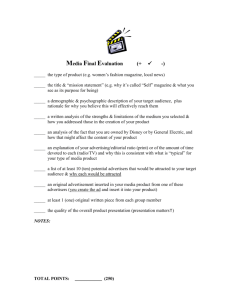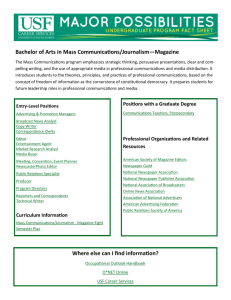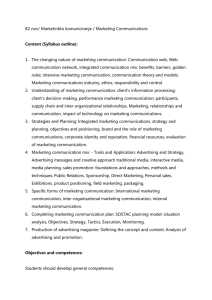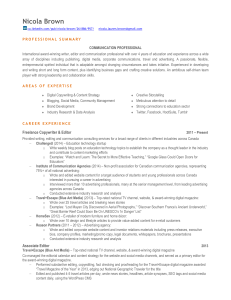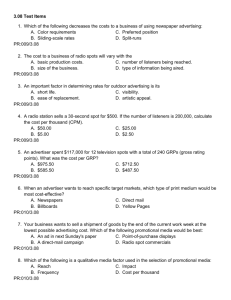Powerpoint - Manitoba Magazine Publishers Association
advertisement
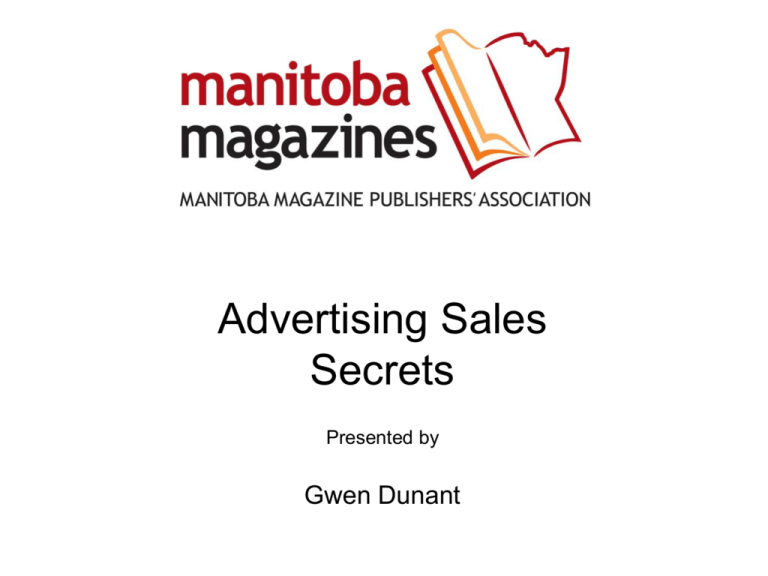
Advertising Sales Secrets Presented by Gwen Dunant I am an advertising sales consultant who sells ad space… My experience tells me that sales reps who have and know how to use proper sales tools sell more advertising with less discounting than those who don’t…. I am an advertising sale consultant who sells ad space… …. yet I see poorly informed sales reps who don’t know what they are really selling, don’t know their magazine’s competitive set, how to us a media kit, or show the value of the magazine so that they can sell against the competition, stay on rate card, close properly and develop effective value-added packages that create good long-term relationships with their clients. Advertisers will spend their money on something they believe will work. A sales rep’s job is to show advertisers why their magazine is the one they should spend their money with. So, to get around this….. “I’m gonna need a break on the price. What can you do for me?” or this….. “Your competition is giving me… a free ad… editorial… advertorial… free online ads…..” ….you need to do this…. Show advertisers the value of advertising in your magazine AND Develop attractive opportunities that allow them to reach your audience. What you are really selling… Regardless of size, budget or circulation, what you are really selling is access to readers in an editorial environment they trust. but let's get back to this….. “Your competition is giving me… a free ad… editorial… advertorial… free online ads…..” but let's get back to this….. One of the hot trends in advertising is for ‘native advertising’ but let's get back to this….. Native advertising is the paid placement of content, often labelled in some way as having been paid for or sponsored by a brand. Sometimes it is written by the brand; other times by the publication’s staff or its freelancers or some combination of the two. but let's get back to this….. Native advertising is not a new concept. Media organizations and magazines have run “sponsored content” and “advertorials” for years. The rise of native ads is the result of a combination of factors: • a brand’s desire to find more effective means of connecting with their consumers • need for new revenue models on the part of the publications • the democratization of content. but let's get back to this….. Native advertising allows brands can tap into a publication’s existing distribution networks and content creation expertise, and leverage the strengths of the publisher’s brand to help promote and propel that content further. but let's get back to this….. Native advertising can be: • Content created by a publication for a brand • Content created by a brand, but placed on a publication’s print or digital property • It can be treated like editorial content with regard to its placement • It can be a section “sponsored” by a brand • Or the company can have a say in the editorial content but let's get back to this….. Native advertising is not right for every brand. ‘Ditch the Pitch’ It works best when brands are looking to tell a story, rather than promote a product. And when it’s created jointly to ensure it looks, and reads like something readers expect from your magazine but is also contextually relevant to the brand. Alternatives to Native Advertising… • Advertorials: Advertorials are created by the brand specifically around brand messaging, and are designed to match the business category in which they will run. This is an ideal for advertisers looking to feature products and service information within a focused environment, such as car-related content in the automotive section or beauty-related product-pieces in the life section, to drive immediacy of response. • Branded content: Also referred to as directed content, branded content is created by a reputable publisher across different mediums such as magazines, web, mobile and video to tell a brand’s story. This approach is ideal for brands looking for greater control of the content Alternatives to Native Advertising… • Sponsored sections: This includes paid sponsorship of editorial sections or planned editorial coverage. Brands have little, if any, influence over content. This is an ideal platform for brands looking to benefit from the visibility of a pre-determined event (such as TIFF) or popular topic of discussion (such as personal finance). • Custom editorial content: This is original content developed by the publisher’s journalists, that halos an advertiser’s message and around which the advertiser’s brand message is exclusively positioned. The advertiser does not have sightline into the content, nor can they impact the content in any way. but let's get back to this….. Native advertising is not right for every brand. What you choose to offer advertisers has to be based on: • Will it enhance the magazine? • Will it alienate readers? • Will it be profitable? Whatever you do, create guidelines for it! To effectively sell against your competition you need to know… The value of advertising in your magazine. The value of advertising in your magazine is…. The things that make it special, unique and different: • Your editorial voice – service journalism, news, fashion • Your readership - the audience you deliver and how you deliver it. • Physical aspects of your magazine, such as the layout, stock, production values…and more! • Offerings – online, off page, events, etc. The value of advertising in your magazine…. Starts with learning your magazine’s place in the market. How do you compare with the competition? How to calculate CPM Advertisers use this as a tool to compare different publications with different rates and circulation. Step 1: Take the circulation of your magazine and divide it by 1,000. For example, if your circulation is 18,000, divide it by 1,000 and you get 18. Step 2: Divide the cost of a full page, four colour ad by the answer you got in Step 1. Let’s say the full page and four colour rate is $1,500. You then divide $1,500 by 18 and this gives you a CPM of $83.33. Sample CPM analysis chart Publication: 1x 4/C Rate: Circulation: CPM: Canadian Living $36,565 512,220 $71.39 Chatelaine $49,400 596,887 $82.76 Cottage Life $11,840 71,528 $165.53 Downhome $1,799 41,380 $70.48 Prairies North $1,705 19,209 $88.76 Saltscapes $6,993 34,688 $72.60 Toronto Life $14,160 92,342 $153.34 Source: CARD and PMB NOTE: These number are fabricated for teaching purposes and are not to be used in a real life setting. TIP: You can use CPM to compare any size or colour ad. Media kits This is how many advertisers will experience your magazine, so it needs to: • Portray your reader to the advertiser. • Speak for you when you aren’t there. • Corroborate claims & add credibility. Media kits Are an opportunity to showcase the strengths of a magazine – the things that make it special, unique and different - so that it shows advertisers the value of the magazine to them. Media kits Should contain all the information needed to sell with so that it becomes a reference source and a script. Media kit contents Four key components: Editorial Information - Editorial Mandate & Editorial Calendar Circulation Information Readership Information Rate Card Editorial mandate Magazine’s voice is a powerful selling tool… • Clear declaration of what your magazine is about. • Showcases your strengths. • Differentiates you from your competition. • Your promise to keep attracting the readers who are your advertiser’s clients. Editorial Environment This is an area where you can set yourself apart. Do you have: • Niche topics • Relevant editorial • High-profile writers • Outstanding photography Circulation “Must Have”information Since rates are based on circulation, you need… • Audit statement • Breakdown by geography, age, profession, etc. • Detailed information about distribution Since you are selling access to readers in an editorial environment they trust, you need to know who your readers are…. You need to know your reader demographics in order to identify your target market: • • • • • Gender Age Income Education Profession You need to match your target market to that of your potential advertisers. PMB Tells you who your readers are http://www.pmb.ca/public/e/product_data/reports_online_gateway.shtml Readership/subscriber surveys Tells you how your readers relate to the magazine Readership Information This is an area where you can set yourself apart. Do you have proven readership surveys that show: • Subscribers read the magazine cover to cover • How much time is spent with the magazine • How magazine affects purchasing (articles/advertising) • Core reader • Demographic breakdown of your readers as well as passalong readership • Geographic breakdown of your readers TIP: Selling access to readers allows you to sell campaigns based on continuity. Sell campaigns based on readership not specific editorial! • Its more time efficient. • Lets you lay out and project future ads. • Lets you offer better placement and helps avoid late ads. It’s better for the advertiser and your magazine. Rate cards Should show: • • • • • • • Net/gross Agency commission Frequency discounts Rates for various sizes Cash discounts Regional breaks Penalties for overdue accounts Rate card • Do the math. • Never go off rate card. • Use rate card as a negotiating tool. Additional Offerings You can’t sell from an empty basket Additional information… You can put whatever you want in it as long as it moves the sale along. TIP: Use the media kit to save time! TIP: Put your media kit online! Put your media kit online! • People like to explore online, especially media buyers. • Your rates are public. • You look like you are hiding something if you don’t. Put You media kit online! Does this work? Hi John, Thank you for your interest in Canadian Hunter Magazine. Please call or email me if you have any questions. Best Regards, Gwen Dunant Canadian Hunter Magazine 4 Duck Street Narnia, ON, Canada L6K 5B9 Building Relationships with clients Clients value sales people who deal with them professionally and help them meet their goals • The difference between being a “friend” and being “friendly” • Don’t confuse being social with doing your job • Don’t be “pesky” be persistent Building Relationships with clients Pesky: repeated calls and emails to buy an ad. Persistence: contacting clients with opportunities, news or offers that would be of benefit to them. What makes a good sales rep? • Selling space is a profession and the goal is to be professional in that profession. • That means being honest, dependable and business-like in your relationship with others. TIP: Mistakes can be relationship builders too! Before you contact the client… • Learn as much as you can about what is being advertised through the client’s web site, sales literature, newspaper, etc. • How do they present themselves? • What aspect f their business do they emphasize? • Find out if there is a fit between what is being advertised and your magazine. • Find out if the client advertises in magazines – how do you compare? Before you contact the client… If the client advertises in magazines – how do you compare? Editorial Readership Circulation Layout Production values Offerings CPM Develop your pitch to highlight what your magazine does best in these areas against your competition. Contacting the client… Do you sell in person, over the phone, or through email? • Likely to do a combination of some or all of these. • Clients will let you know the best way to communicate with them. Know your client’s preferences! • Are they partial to email, phone calls, drop offs, pop-ins, lunch invites, swag? • Is there a time of day or day of the week that is the best for reaching them? • Do they like to schmooze or cut to the chase? • Do they respond to authority? Would it help to “cc” your management or senior players on their team? Know your client’s advertising objectives Why are they advertising? • To move inventory? • Create awareness? • Keep up with their competitors? • Image building? Know your advertising objectives for the client… • Sell a print campaign? • Sell a print/online campaign? • Upselling what they have in the competition? Selling starts with listening Selling is: 90% listening & 10% talking “I never learned anything when I was talking.” Larry King Interview technique • Who do they want to reach? • Where are they advertising now? • What do they look for when choosing advertising? • What do they like about where they are now? • Who is their competition? • What makes their business unique and different from their competition? Interview technique Don’t interrupt! You have to find out what your customers are thinking so don’t finish their sentences, interrupt or assume you know where they are going with a thought. Building the Fit… Start using the research and you’ve done and the information the client has given you to show how your magazine is the perfect advertising vehicle for them. Building the fit… Features & Benefits It’s not about your grass seed, it’s about their lawn. Your job is to manage the sales process Selling is an ongoing process so you must keep moving the sale along by giving clients: • Direction • Next steps • Deadlines to respond Close! You must close the sale! You’ve built the fit, shown the value of advertising in your magazine, closing the sale is the next logical step. Closing is not… Thinking, feeling or wondering…. “Do you think you might want to advertise in my magazine?” “How do you feel about advertising in my magazine?” “I’m wondering if you want to advertise in my magazine?” Wishy-washy questions, will get you wishy-washy answers. Close! “I recommend we begin your campaign in our June issue with a half page four colour advertisement….” You will either get the business or you will get objections. Handling objections Client will not buy until they are sure they are making the right decision. See objections for what they often are: • An objection isn’t a “No” – it’s your cue to start selling • Requests for information and another opportunity to sell. Handling objections Requests for information and another opportunity to sell: “Your circulation is too small” – you didn’t shown them that it was the right circulation. “You don’t reach my market” – you haven’t shown them that you do. “You don’t give free pages like your competition” - you haven’t shown them why advertising in your magazine is worth it Handling objections And the most dreaded objection: We don’t have the budget. It means you haven’t convinced them of the value of your magazine. Handling objections We don’t have the budget… Is not permission to negotiate price but get creative: Value-added, post-dated cheques, waive terms, rate-protection, monthly payments, etc. TIP: Sometimes “We don’t have the money” from a past advertiser means they haven’t paid their last invoice. Clean up the debt and advertising will likely resume Work as a consultant to get around common ‘dodges’…. “I don’t have an answer yet” – “Is there anything I can do to move this along?” “I’ll let you know next week” – “Is there anything more you need from me in order to make the decision to advertise with us?” “I’m not ready to make a decision yet” - “How can I help you make that decision?” Consider this before you ‘deal’… Sometimes you do leave money on the table if it will affect other advertisers and erode confidence in sales staff. Sometimes walking away will get you the respect and ultimately the dollars you need and deserve. Gwen’s Top 10 Sales Tips Never let a contract expire. Once advertisers learn they can live with out you, they do. Make sure your rates are in line. Too many publishers give too much away. Don’t do the clients thinking for them. “I won’t call him about our upcoming issues cause I know he doesn’t have the money”. It stops you from selling to them. Don’t buy the client’s excuses for not buying advertising space. “It’s not a good time…”, etc. It stops you from selling to them by waiting till there is a good time. Realize that objections aren’t “No”. They are often requests for more information or help. Don’t get caught up in other problems with the magazine. It derails the sales conversation. Sell readership not editorial. This lets you sell campaigns based on continuity. Sales is 90% listening and 10% talking. Effective sales people listen more than they talk. To make money today, upsell your current clients. They are already sold on the magazine. Wishy washy questions yield wishy washy answers Q: “Do you think you might be interested in advertising with us?” A: “Perhaps that might be worth thinking about”. Thank you! An example…. The Atlantic’s failed Scientology experiment embedded the term “native advertising” into our collective advertising consciousness. Before their experiment, the earliest search for the term “native advertising” appears in February 2011, and it didn’t climb into double digit searches until November 2012. Why did they pull it? Here’s what the Atlantic did wrong: Used a mushy expression “Sponsor Content.” It’s what publishers use when they don’t want ads to look like ads. The design layout looked too much like the design of Atlantic. The editorial looks too much like Atlantic editorial. They also forgot a clear call to action.
